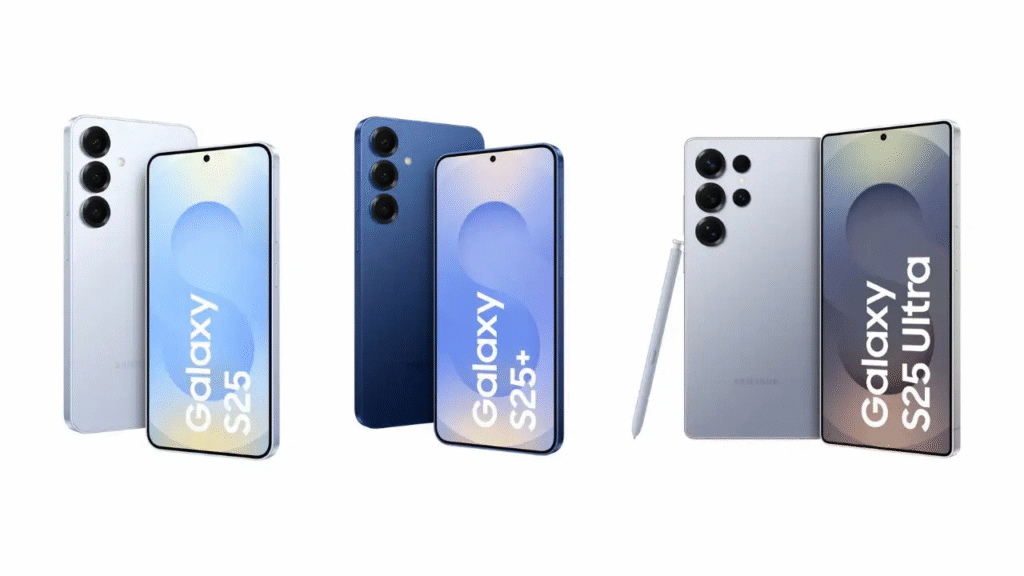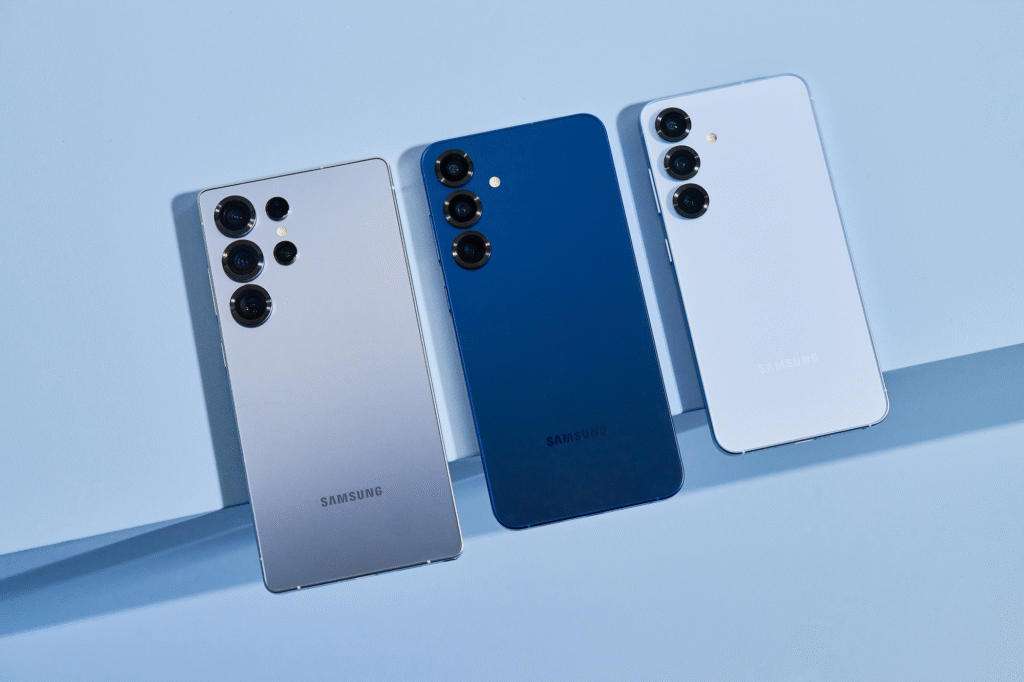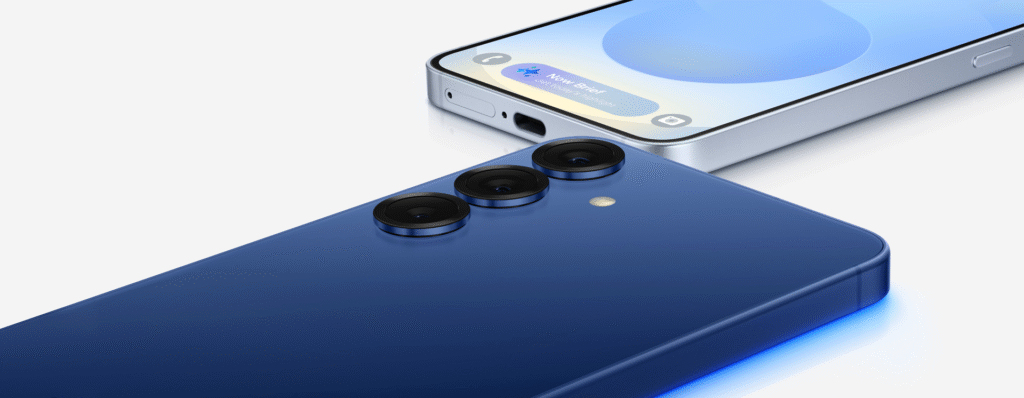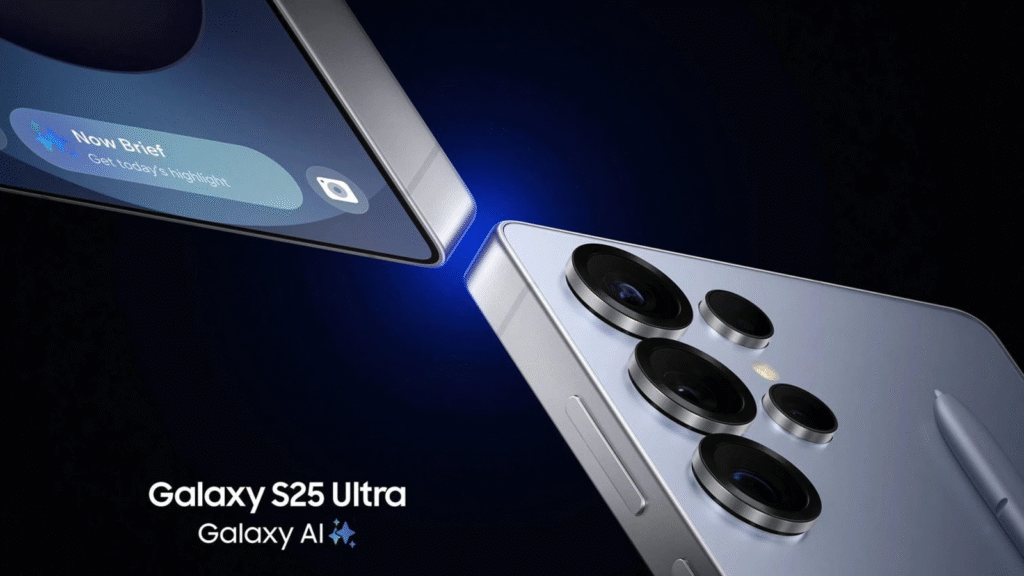The Samsung Galaxy S25 Series is not a revolution. It does not have to be. Rather, it’s a fine honing of a successful formula that now extends beyond hardware nuance into the world of artificial intelligence, long-term software worth, and frictionless device integration. With Galaxy S25, S25+, S25 Ultra, and a pleasant surprise—Galaxy S25 Edge—Samsung has designed its most rounded flagship series yet. This lineup is not an upgrade for the sake of upgrading; it is a considered assertion on Samsung’s part that high-end smartphones can evolve smartly and not explosively.

Where the S24 Series was about streamlining the physical presence and doubling down on ecosystem efficiency, the S25 Series is about turning that experience smarter, more intuitive, and emotionally rewarding. The revolution happens in the details—smarter software choices, a more robust camera system, extended battery life, and nuanced design refinements that feel like hearing as opposed to surmising.
Design and Build: High-End Familiarity with Progressive Tones
At first glance, the Galaxy S25 Series is familiar-looking—Samsung is not pursuing radical form factor change, but polishing what already works. The base S25 and S25+ are trimmed down slightly and weighed less this year, with flatter edges as a nod to user feedback, becoming easier to hold and more comfortable to use one-handed. The aluminum body remains Armor Aluminum, which Samsung has thoroughly tested for rigidity, and the front and back are guarded with Corning Gorilla Glass Victus 2—bearing a balance of durability and sophistication.
The S25 Edge deserves a paragraph of its own. It’s Samsung’s return to aggressively curved design, but with contemporary sense. With an edge-to-edge 6.4-inch screen that curves into an incredibly thin 5.8mm body, the S25 Edge has the smallest footprint of the group and could be the most visually appealing Samsung device in years. It looks like it’s from the future but retains functionality.
Then there is the Galaxy S25 Ultra, Samsung’s still unchallenged productivity champion. It has the same sturdy, angular design with titanium edges that recall the Galaxy S24 Ultra, but now with marginally softer curves to enhance ergonomics. It’s still the only one with the internal S Pen—Samsung isn’t abandoning the stylus anytime soon—and boasts the best thermal design and battery cooling system on the lineup.
Color choices run the gamut of professional and fun: Onyx Black, Ice Blue, Sandstone Cream, and Graphite Gray are default, while Samsung.com-exclusive colors such as Lilac Purple and Emerald Green add panache for those seeking differentiation. The IP68 water and dust resistant rating throughout the lineup provides a solid basis of durability.
Display: Brightness, Brilliance, and Better AI Adaptation
Samsung’s displays have never been better, and the S25 Series is no exception. Every model boasts the newest Dynamic AMOLED 2X displays, brighter than ever before. The Galaxy S25 and S25+ offer up to 2,800 nits of peak brightness, and the Ultra and Edge models reach up to 3,000 nits. That eliminates screen-watching difficulties in the sun—the screen stays crisp, colorful, and glare-free in almost any setting.
What gives the S25 series’ screens their edge isn’t merely raw brightness. It’s the fact that Samsung employs AI to constantly calibrate and tweak color profiles, brightness zones, and contrast ratios. HDR10+ content or Dolby Vision video is eye-popping, with blacks even darker and light control even sharper. Adaptive refresh rate remains 1–120Hz, courtesy of LTPO 3.0 panels, which are smoother and more power-efficient this year.
Samsung has also fine-tuned Eye Comfort mode with AI. It does more than switch to warmer color temperatures—it detects your usage pattern, ambient light temperature, and application behavior to provide context-aware calibration minimizing fatigue at the expense of vibrancy. Whether you’re gaming, reading, or binge-watching, the S25 Series visually adapts like a smart friend.

Performance: Snapdragon and Exynos Return in Harmony
The S25 Series retains the dual-chip strategy, with Qualcomm’s Snapdragon 8 Gen 4 SoC on the majority of global models and Samsung’s in-house Exynos 2500 on some parts of the world. However, this time around, the performance disparity is virtually eliminated due to a more effective cooperation between Samsung and AMD for Exynos GPU integration and closer optimization on both platforms by Galaxy AI.
The Snapdragon 8 Gen 4 within the S25 Ultra and S25 Edge packs serious muscle with a particular emphasis on generative workloads, on-device AI boost, and power-efficient thermal scaling. It’s the first smartphone chip to implement a custom NPU design dedicated to LLM (Large Language Model) inference—that is, real-time transcription, translation, and image creation can be done locally without having to transmit data to the cloud. The outcome is more privacy and substantially faster AI interactions.
The Exynos 2500 driving the S25 and S25+ is equally competent in most practical chores, with only a slight gap in record frame rates and artificial tests. Both feature up to 12GB of LPDDR5X RAM and UFS 4.1 storage for quick app opening and seamless multitasking. Gaming performance has also been focused on, with ray tracing support in current games now available and enhanced Game Booster enhancements controlling heat and resource distribution during a session.
Samsung’s Galaxy AI drives everything from scene-aware processing in the camera app to generative wallpapers, AI wallpaper design, and intelligent summarization features for documents, web pages, and even meetings captured with the built-in Voice Recorder app. This is a more intelligent Galaxy, not merely a quicker one.
Camera System: Computational Photography Reaches New Heights
The Galaxy S25 Ultra continues to set the pace with its quad-camera system. A 200MP main sensor tops the selection, but the news here is that Samsung has added a wider 1-inch sensor for the first time, which delivers DSLR-grade light absorption and shallow depth-of-field. The periscope lens is improved with a 50MP sensor providing 5x optical zoom with dual-pixel autofocus, along with the 10MP 3x tele, and 12MP ultrawide completing the package. Image processing, though, is where the jump really happens.
Samsung employs Galaxy AI to drive “Instant Scene Reconstruction,” assessing texture, lighting, and motion in several frames in real-time. This minimizes motion blur, adjusts skin tones, and adapts saturation dynamically to ensure realism. AI framing intelligently suggests optimal crop based on subject position, and new motion templates can be applied to transform Live Photos into cinematic videos with dynamic pans and zooms.
The S25 and S25+ retain a more conservative triple-camera setup, with a 50MP OIS main camera, 12MP ultrawide, and new 10MP 3x tele. These aren’t an afterthought—the smaller phones now enjoy much of the computational advancements that were once reserved for the Ultra model, even making the budget S25 a serious shooter.
All front cameras now employ a 12MP AI-powered sensor that can do depth fusion natively, making selfies sharper and subject isolation in portrait mode more precise. Video recording is capped at 8K on the Ultra, and the rest at 4K 60fps with full HDR pipeline.

Battery and Charging: Wiser Longevity Instead of Brute Power
The Galaxy S25 Series isn’t breaking boundaries when it comes to battery capacity, but Samsung has set its sights on endurance via intelligence. The S25 has a 4,000mAh battery, the S25+ raises that to 4,800mAh, and the Ultra features a 5,500mAh cell—thanks to enhanced internal stacking and board design. The S25 Edge contains a 4,300mAh battery in a notably slim package, with help from AI-boosted power scaling.
Charging speed is still 45W wired and 25W wireless for all but the Ultra, which has 65W wired charging with the new Super Fast Charger 2.0. AI battery learning in the real world is achieved through improvements in adapting not only to your charging patterns but also the app types you use—throttling background activity during long idle times automatically or quickly spiking CPU cores to quickly complete burst workloads.
The reverse wireless charging, adaptive thermal throttling, and Smart Charging 3.0 (to maintain battery health for years) are built in across the lineup.
Software and Ecosystem: Galaxy AI Everywhere
Samsung’s software play is strongest yet. One UI 7, founded upon Android 15, arrives with the Galaxy S25 Series and introduces a richly integrated Galaxy AI platform. Capabilities such as Chat Assist (tone modulation, translation), Transcript Assist (summaries of meetings), and Circle to Search are now accomplished entirely on-device for privacy and performance.
AI Themes let users recast their entire phone UI from lockscreen through system icons with a handful of keywords. Samsung Notes gains AI-created outlines, summaries, and intelligent formatting. DeX mode receives wireless multi-window functionality, making the Ultra a proper desktop replacement. Link to Windows, SmartThings automation, Galaxy Buds auto-switching, and tablet-pairing with the Galaxy Tab S10 round out the tightly connected Samsung experience.
Most notable, though, is Samsung’s software support pledge: 7 years of OS and security updates, tying the Galaxy S25 Series on a par with Google’s Pixel support promise, allowing buyers to maintain their phones for longer with promised freshness.
Connectivity and Multimedia
All S25 models have Wi-Fi 7, Bluetooth 5.4, 5G sub-6GHz and mmWave (region specific), and are equipped with UWB features for accurate location tracking and SmartTag+ support. The Ultra and Plus models also have dual-frequency GPS for enhanced navigation precision.
Audio is enhanced using stereo speakers that are tuned by AKG with Dolby Atmos. Haptics have been revamped with new vibration motors for nuanced, multi-directional response, which boosts gameplay and overall UI feedback. A headphone jack does not exist, although high-resolution wireless audio and Samsung Seamless Codec provide the best audio for Bluetooth.

Pricing and Availability
The Galaxy S25 begins at $899 USD, S25+ at $999, S25 Edge at $949, and the Galaxy S25 Ultra starts at $1,299 for the starting 256GB model. Storage capacities rise up to 1TB with the Ultra, with carrier offers, trade-in discounts, and bundle pricing accessible on Samsung.com, carriers, and retailers worldwide. The products now roll out in North America, Europe, India, Southeast Asia, and select Latin American markets.
Final Verdict
Samsung Galaxy S25 Series does not attempt to surprise or innovate—it simply listens, improves, and heightens. From smart display adjustments and radically enhanced AI capabilities to reliable battery life and industry-leading camera capabilities, the S25 series accomplishes just what today’s users demand—and more.
The Ultra remains the undisputed Android productivity king. The S25+ finds that perfect balance between size and battery strength. The S25 stays compact but flagship-caliber. And the S25 Edge is a daring back-to-form statement for those who hunger for visual beauty.
In a mature smartphone market, the Galaxy S25 Series shows that the future of flagships isn’t only about revolutionary change, but rather precision and perfection.
Leave a Reply